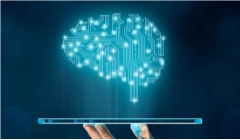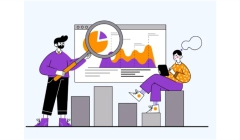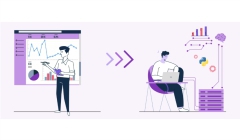
With the increasing importance of data science in the current world, it has become a highly coveted career choice. Whether you're a student, a working professional, or planning to change careers altogether, embarking on a career in data science can be overwhelming and exciting at the same time. A question most aspirants ask is — "What should I learn first for data science?
" Knowing the correct starting point is crucial to establishing a solid foundation and speeding up your journey toward becoming a successful data scientist.
Why Starting Right Matters in Data Science
Data science is an interdisciplinary field of study that incorporates mathematics, statistics, computer science, and domain expertise. One should tackle it in a step-by-step manner to prevent confusion as well as burnout. Starting with the proper set of ideas and tools, students can increasingly develop skills for solving practical problems with data.
Key Skills to Learn First for Data Science
If you are curious about where to begin with data science, here's a list of subjects you need to learn first:
Let's go through each of these basic subjects and see why they are the most important for beginners.
1. Learn Mathematics and Statistics for Data Science
Why Is It Important?
Math and statistics are the pillars of data science. They are used to understand the behavior of data, create models, and make conclusions. Lacking a firm foundation in these fields, it is guesswork to interpret results based on data.
What To Concentrate On?
Linear Algebra: Vectors, matrices, and operations are basic requirements for machine learning algorithms.
Probability Theory: Comprehending distributions, rules of probability, and Bayes' theorem.
Descriptive Statistics: Mean, median, mode, variance, and standard deviation.
Inferential Statistics: Hypothesis testing, confidence intervals, p-values, and regression analysis.
How It Helps:
Learning mathematics and statistics beforehand allows you to:
2. Master Python Programming for Data Science
Why Choose Python First?
Python is the most popular language among data scientists. It is easy to understand and has highly effective libraries that make it perfect for learning first.
What Should You Learn in Python?
Relevance to Data Science:
Python enables data scientists to:
3. Explore Data Analysis and Data Visualization
Why This Step Matters?
Now that you understand how to code, you need to apply your programming skills to understand datasets. Data analysis and visualization allow you to discover useful insights and narrate a story with the data.
Key Concepts to Master:
Data Cleaning: Managing missing values, duplicates, and outliers.
Exploratory Data Analysis (EDA): Statistical summaries and graphs to comprehend data.
Visualization Tools: Matplotlib, Seaborn, Plotly
Practical Applications:
4. SQL and Database Management
Why Learn SQL Early?
Data tends to be stored in structured forms such as relational databases. SQL knowledge allows you to access, filter, and analyze this data in a streamlined way.
Topics to Cover:
Job Relevance:
5. Learn Basic Machine Learning Concepts
When to Begin ML?
After you feel comfortable with data analysis, programming, and statistics, it is time to move on to machine learning. Beginning too early may confuse you in the absence of a solid foundation.
Central ML Topics to Begin With:
Supervised Learning: Linear regression, logistic regression, decision trees
Unsupervised Learning: Clustering, dimensionality reduction
Model Evaluation Metrics: Accuracy, precision, recall, F1-score
Overfitting & Underfitting Concepts
Tools to Practice:
6. Practice What You've Learned through Real-World Projects
Why Projects Matter?
Projects pull everything together — they enhance your problem-solving skill and showcase your abilities to employers. They're also important in the development of a data science portfolio.
Project Ideas for Beginners:
Advantages:
Bonus: Soft Skills and Career Essentials
Besides technical skills, acquiring soft skills is also crucial for a successful data science career.
Major Non-Technical Skills:
Recommended Learning Timeline to Become a Data Scientist
Month Focus Area
This structured approach helps you develop a strong foundation first before diving into advanced topics such as deep learning or big data tools.
Frequently Asked Questions (FAQs)
1. Can I learn data science without a computer science background?
Yes, you can. An interest in mathematics, programming, and problem-solving is sufficient to begin. Numerous professionals with non-technical backgrounds have successfully switched.
2. Must I first learn R?
No. Python is more practical and easier to learn. After getting familiar with Python, learning R for statistical analysis is optional but useful.
3. Is data science difficult for beginners?
It can be difficult at first, but with a well-defined learning plan and regular practice, anyone can master data science.
4. Must I take a course or learn by myself?
Both are feasible. Systematic offline or online courses can facilitate quick learning, whereas self-learning provides flexibility and depth.
What Should You Learn First for Data Science?
Getting started with data science can be exciting if you have the correct roadmap. Start with the basics — statistics, Python, data analysis, and SQL — and then move on to machine learning and real-world projects. Don't hurry. Develop your skills gradually, and always keep in mind solving actual problems with data.

With businesses of all types embracing data-driven models, data science has emerged as the most in-demand profession in the world. No wonder thousands of students are opting for online data science courses to initiate or transition a career in this field. However, the million-dollar question lies in whether an online data science course will be sufficient enough to land a job.
This blog delves into the true worth of online data science education, the skills most sought after by employers, and how one can best increase one's chances of getting a job—particularly in tough job markets such as India.
Why So Many Are Resorting to Online Courses?
Online courses have unparalleled flexibility and convenience, particularly for working individuals and students wishing to reskill or career-shift into tech jobs.
Here's why online courses are increasingly popular:
Can an Online Data Science Course Get You a Job?
The short answer is: Yes, it can—but only if done right.
Finishing an online course in data science is a good starting point to get into the profession. But getting hired in data science relies on much more than passing courses. They seek actual skills, working experience, and a good portfolio.
What Recruiters Really Want in Data Science Recruits
Unless you're a fresher or a career apprentice, corporations expect you to prove:
Advantages and Disadvantages of Online Data Science Courses
Let us dissect the benefits and constraints of online courses from a job-readiness standpoint.
✅ Pros
❌ Cons
When Is a Single Online Data Science Course Sufficient?
When you wonder whether a single online course will get you hired, the response relies on:
An online course is "sufficient" if:
Step-by-Step Plan to Make an Online Course Career-Worthy
1. Select the Correct Online Course
Search for courses that deal with:
2. Practice What You Learn
Don't learn passively—implement what you learn.
Practice through:
Spend time on:
3. Build and Showcase a Strong Portfolio
Your project portfolio is your biggest selling point, particularly for self-taught or fresher professionals.
Add projects such as:
Display your work on:
4. Earn Recognized Certifications
Some online platforms and training institutes offer certificates of completion. While these don't guarantee a job, recognized certifications can add value to your resume and improve your credibility.
Certifications may help when:
5. Network and Participate in the Community
Networking often opens more doors than degrees. Join online groups, attend webinars, and participate in hackathons.
Where to network:
6. Job Interview Preparation
Most hiring sessions comprise:
Practice:
Common Job Designations You Can Look For
Once you are done with an online data science course and have acquired your skills, you can look for entry-level or analyst positions.
Well-known job designations:
Leading industries hiring data scientists:
Recruiters' favorite tools and platforms:
What If You're a Fresher?
Most companies are willing to employ freshers or early-career professionals if you show hands-on skills and passion.
Freshers' tips:
Can You Get a Job Without a Degree?
Yes. Having a computer science or statistics degree is helpful but not necessary if you possess:
Is One Course Enough?
One high-quality online course is a good beginning, but learning doesn't end there. Keep your skills upgraded through:
FAQs – Online Data Science Courses and Jobs
Q1. Do I qualify for a job after taking an online data science course?
Yes, as long as you also show practical skills with projects and interviews.
Q2. Is data science certification worth it?
Certifications help your resume but are not a replacement for actual skills and experience.
Q3. What is the salary after taking an online course in data science?
Off-campus freshers pay ₹4 LPA–₹10 LPA in India or more. Compensation is dependent on skills, projects, and the company.
Q4. Do I need a degree to be a data scientist?
Yes, if you are able to demonstrate expertise in foundation topics such as Python, ML, and data analytics through self-study and projects.
Q5. How can I identify a job-oriented online course?
Select courses that involve projects, interview preparation, certifications, and assignments.
Make Your Online Learning a Career
Online courses in data science are more than sufficient to find employment—if you put them to proper use. Do not emphasize course completion alone; emphasize acquiring skills. Build projects, get certified, and present your work assertively.
In a talent-first recruitment era, it is not where you studied that really matters, but what you can do using what you have studied. You can be a working professional, a college student, or a beginner, but with the right attitude and strategy, your online course can turn out to be your foot in the door to a successful career in data science.

With the advent of the digital age, data serves as the driving force behind every decision in nearly every industry—healthcare, finance, education, or entertainment. As big data has taken the world by storm, data science has become one of the most popular professions worldwide. The better news? You don't have to wait for your postgraduation to step into this arena. If you are asking yourself how to be a data scientist after 12th, this blog will give you a step-by-step, comprehensive guide specific to Indian students and learners across the globe.
Starting early provides you with a huge advantage in:
Here's an overview of the journey:
Step 1: Select the Proper Stream Post 12th
To be a data scientist, it's best to study Science (PCM) or Commerce with Maths in your 11th and 12th standards. These streams will provide you with a head-start in the fields of:
Mathematics – essential for algorithms and statistics
Computer Science – useful in developing programming logic
Physics – enhances analytical and logical reasoning
Some of the most popular degree options after 12th:
Step 2: Choose an Appropriate Undergraduate Degree
A bachelor's degree is the building block for a career as a data scientist. In this phase, be careful while choosing courses that have classes such as:
You may opt for:
Pro Tip: There are also specialized B.Sc in Data Science courses offered by some colleges.
Step 3: Learn Programming Languages
Programming is a must for data science. Although there are many languages employed in the field, the most beginner-friendly and ubiquitous is Python.
Languages to learn:
Python: Easy to read and with mighty libraries (Pandas, NumPy, Scikit-learn)
R: Very good for statistical analysis and data visualization
SQL: To query and maintain structured databases
Learning platforms:
Step 4: Build a Foundation in Math and Statistics
Mathematics is the foundation of data science. A firm understanding of mathematical principles will aid in comprehending machine learning models and algorithms.
Focus areas:
Real-life example: Customer behavior analysis through probability models.
Step 5: Learn to Work with Databases and Data
Data scientists must process and extract data from various sources.
Skills to learn:
Projects:
Step 6: Learn Data Visualization Techniques
Conveying insights using visualizations is an important skill.
Learn tools such as:
Types of charts to learn:
Tip: Utilize data visualization to display your projects during interviews and web portfolios.
Step 7: Master Machine Learning Fundamentals
Once you have a grasp of programming and handling data, begin learning machine learning—the core of data science.
Critical algorithms to master:
Begin with supervised learning, followed by unsupervised and reinforcement learning.
Tools: Scikit-learn, TensorFlow (for deep learning later)
Step 8: Work on Projects to Create a Portfolio
Companies need evidence of your capabilities. Creating real-world projects aids in proving your capability.
Beginner project ideas:
Where to present:
Step 9: Take Online Courses or Certifications
Along with your training or college, pursue data science certification courses to enhance your skillset.
Select courses that touch on:
Course deliveries:
Step 10: Internship and Entry-Level Job Applications
During your last year of college or after completing a course of training, begin applying for positions like:
Where to apply:
Interview preparation tips:
Step 11: Higher Education (Optional)
While certifications and a UG degree are frequently sufficient, some might opt for higher education to enhance their academic record.
Options:
Higher studies can help if you’re aiming for research roles, leadership positions, or jobs in MNCs with high academic requirements.
Step 12: Stay Updated and Network with the Data Science Community
Learning in data science never stops. Join active communities to stay updated.
Join platforms like:
Benefits:
Stay informed with:
FAQs – Data Science After 12th
Q1. Is it possible to become a data scientist right after 12th?
Not right away, but you can begin preparing immediately after 12th. A UG degree + relevant skills, certifications, and projects can get you job-ready in 3–4 years.
Q2. Which subject is best to choose for data science after 12th?
Science with Mathematics is ideal. Commerce with Maths can be used as an alternative if you pick up coding and statistics.
Q3. Is data science a good career option in India?
Yes. High demand in all industries and fat salary packages make it a future-proof career option.
Q4. How much does a data scientist get paid in India?
Data scientists can earn ₹6–10 LPA as freshers. With experience, they can get ₹20 LPA and more in top companies.
Q5. Which are the best certifications to opt for during college?
Python, SQL, Machine Learning, and Data Science fundamentals certifications are recommended.
Start Your Data Science Journey Today
It is not only possible to become a data scientist after 12th—it's one of the wisest career choices you can make in the era of AI and digital transformation. Science, commerce, or arts students with analytical mindsets, regardless of their academic backgrounds, by starting early, have time to learn in-demand tools and technologies to a mastery level.
Use the roadmap outlined above to begin learning fundamental skills such as Python programming, statistics, machine learning, and data visualization. Prioritize developing a solid academic foundation, working on real-world projects, and obtaining certifications that authenticate your expertise. With hard work and an improvement mindset, you will be an accomplished data scientist by your early 20s—prepared to transform and direct in a data-driven world.